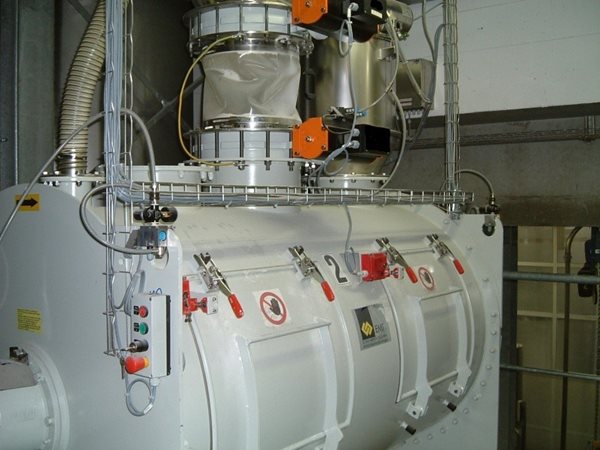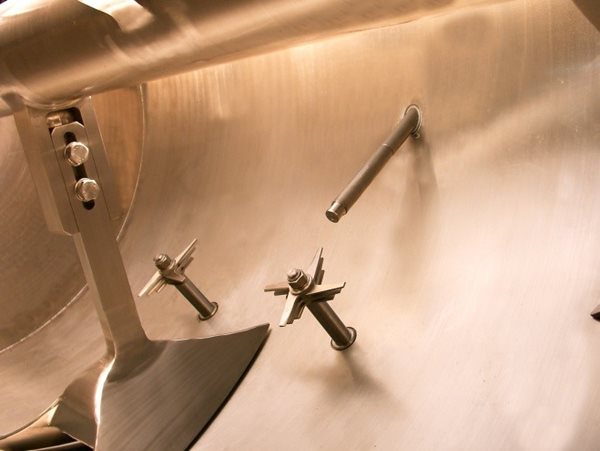The right mixture makes the difference: The designing of batch mixers in food applications
2/4/2020
|
Promotion
Be it sugar, cocoa, starch or flour - bulk materials are processed in almost every manufacturing process of the food industry. The resulting products are quite often a variety of ingredients, which must be mixed in a predefined mixing ratio. However, the best recipes and proper amounts do not inevitably lead to high-quality products. Especially in cases where the materials have very different properties (such as bulk density), the selection of the right mixing method or the interpretation of the mixing technique is crucial for the achievement of an ideal and, above all, constant and optimum mixing result.
In addition to the classic mixer requirements, such as short mixing time, homogeneity of the mixture and processing quality, hygiene and food safety are clearly in the foreground when it comes to food applications. The introduction of important production standards, such as the ones formulated in EU 1935/2004 or by the FDA and EHEDG, provide clear guidelines for equipment and component manufacturers, specifying the circumstances under which their products may be used for the production of foodstuffs.

Hygiene and cleanliness are of the highest priority
In food production, nothing is more important than cleanliness - and this is for various good reasons. Many ingredients are perishable and, in case of insufficient cleaning, they facilitate the formation of germs, which can contaminate downstream batches. In extreme cases, the health of consumers may even be at risk. Moreover, in the case of frequently changing recipes within a production line, it is important that the previously prepared products can be rapidly and completely removed from the process or production machines. Otherwise, batches will be contaminated and the customer might not obtain the usual product quality, as regards taste, texture or colour, which may suddenly be different than expected. Therefore, cleanliness and hygiene are a prerequisite for a consistent high product quality for all batches.
In this context, mixers in the food industry have to be easy to clean and, above all, residue-free. All parts of the production equipment that come into contact with the product must be manufactured so that the respective surfaces can be cleaned without leaving any residue. Therefore, in the case of a high-quality batch mixer, all critical components, such as mixing chamber, mixer shaft, mixing tools, as well as loading and emptying module should be manufactured from materials that are resistant and have particularly smooth surfaces. Here, stainless steel has been established as the standard. With additional surface treatments, roughness can be further reduced (e.g. 0.8 μm). Glass bead blasted or mirror polished surfaces are a common finishing. Since seals are also often in contact with the product, they must be made of materials suitable for food production.
In addition to these material-specific aspects, higher standards are going to be implemented for greater hygiene and efficiency, especially on a design level. Nevertheless, the same applies here as well: the smoother, the better. The mixing chamber and all the tools inside should show as little as possible or, ideally, no clearance and dead spaces at all - i.e. small niches, in which product might settle, which, even after repeated and thorough cleaning, may continue to adhere and even lead to the formation of germs. Therefore, in the parts of the mixer that come into contact with the product, such as the mixing chamber, all connections of the individual components must be rounded while welding seams must be cleanly smoothed and free of cracks and gaps.
In many systems, mixers have to be cleaned several times a day due to frequently changing recipes. Here, those mixer models are advantageous, which provide quick and extensive access to the mixing drum and tools. All internal parts should be easily accessible and cleanable, so that unnecessary downtime can be avoided. This is an important factor as in certain applications mixing time per batch is shorter than the duration of the cleaning after the mixer has been emptied.

Versatility and efficiency in the production process
Modern batch mixers are powerful and versatile mixing systems that have been designed to provide optimum mixing results for almost all mixing operations. Using various mixing tools, such as ploughshares, shovel blades, ribbon flights or cutting choppers, the most diverse mixture compositions and mixing processes can be achieved with the same mixer. The starting point in determining the optimum mixing process is the mixed material or the characteristics of the single raw materials and their behaviour during mixing.
In the case of abrasive mixtures, it is advisable to work with anti-wear mixing chamber linings and tool coatings - but always with consideration to the food-suitability of the materials used. On the contrary, when working with ingredients that are prone to lumping, rotating choppers are to be used, which are incorporated in the casing of the mixing chamber and are to be provided with their own drives.
Further common accessories in batch mixers are: liquid addition systems for applications in which the liquid ingredient has to be dosed into the mixing chamber, jacketed mixing chambers for heating or cooling, as well as sampling devices.
Another important aspect in the design of a mixer is its discharge behaviour. Short mixing time and high productivity can be fully exploited only if the mixer is quickly and completely emptied after the mixing process. Some mixer types provide an integral drain, i.e. a discharge hatch over the entire length of the mixing chamber, through which the mixer can be emptied within seconds.
Caution: explosion hazard
Mixing technology is also exposed to particular hazards due to dusty bulk materials, which can create an explosive atmosphere inside the mixing chamber. As in other industrial sectors, appropriate explosion protection guidelines (ATEX) are applicable in such plant areas, i.e. only such production equipment may be used, which provides the security features necessary for this application environment. For example, no electrical parts are to be installed in the mixing chamber, as these, in case of failure, may cause an explosion as a result of a spark coming into contact with the dust cloud.
Therefore, de-dusting of the mixer is critical in the case of dusty mixtures. The batch mixer should be equipped with a powerful dust extraction system, which is to suck out the explosive dust from the mixing chamber, thus reliably separating dust particles from the air stream. Note: mixer de-dusting systems also have to be certified for use with food products.